Create
Vintage St. Pete: The Science Center (Part One)

Part One of three.
The test tubes, bunsen burners, beakers and bird bones are long gone. There are no aquariums, no rock specimens, no rocketry fuses and no coils of copper wire for hand-building simple radios.
There hasn’t been a Periodic Table of the Elements on the walls of the Science Center of Pinellas County for half a decade.
The concrete block building at 7701 22nd Avenue N. has sat empty, unused and unappreciated since 2019. That’s when age finally caught up with it, and the money simply ran out.
When the Science Center opened in this location, in 1966, it was a jewel in St. Petersburg’s crown, the first nonprofit dedicated solely to independent science education for children grade school age and up.
Over time, it’s estimated that hundreds of thousands of youngsters visited the Science Center for morning “field trip” classes, weekends and summer camps.
There were no grades. Classes were taught by professional science educators, many of them retired, all of them committed to the idea that learning about the natural world, and other important subjects from rocketry to chemistry to (in the 21st century) computer literacy was key to a well-rounded education. And that it could be exciting.
 The father of the Science Center was William Guild, a recently-widowed retiree from Massachusetts who took a small apartment on Mirror Lake Drive in 1952. The wiry 60-year-old was a former newspaperman who’d subsequently spent 40 years as a realtor, but his passion was science.
The father of the Science Center was William Guild, a recently-widowed retiree from Massachusetts who took a small apartment on Mirror Lake Drive in 1952. The wiry 60-year-old was a former newspaperman who’d subsequently spent 40 years as a realtor, but his passion was science.
Guild, who’d never finished college, was an amateur naturalist, and he found the mostly-undeveloped Pinellas County a veritable garden of discovery.
He and other naturalists created an informal group they called the Science Club of St. Petersburg. Retired entomologist and head of the local Audubon chapter Alfred F. Satterthwait was voted president. Guild, one of just two amateurs in the group, became head of the educational component. Others were experts in wildflowers, fossil shells, trees and taxidermy.
The group embarked on field-collecting trips (“walkie-talkies”) and met on the third Tuesday of each month at the Museum of History.
After a Science Club exhibit of local wonders attracted crowds to St. Petersburg Junior College, Guild reached out to the Pinellas County School system and proposed his group help supply experiments and exhibits for their science classes. “These individuals could be of inestimable value to our school in helping to collect, arrange and classify exhibits for science,” said St. Pete High principal C. Taylor Whittier.
Within a year, the club received project requests from 45 of the 54 schools in Pinellas, from electronics to hydroponics. The first semi-permanent iteration of the newly-named Science Center was at Mirror Lake Junior High.
The Science Center coined a motto: “Science is Fun. See it – Touch it – Do it Yourself!”
In April, 1954: Guild produced St. Petersburg’s first-ever Science Fair, held at Bartlett Park Youth Center. After working successfully with the Pinellas Science Teachers Association and a trio of state universities on 300 displays on everything from meteorological phenomena, astronomy and chemistry to live animals with taxonomy information, he began to formulate plans for an actual Science Center: A dedicated facility where regular classes could be held, experiments undertaken, the wonders of the natural world examined and discussed.
Plus, the apartment and garage on Mirror Lake Drive was getting cramped with equipment, and wall-to-wall with the constant visits from children wanting to know about turtles, snakes, plants or rocks.
Parents magazine profiled Guild in 1955; the story was subsequently reprinted in Readers Digest, which referred to the “lively little man” as “The Pied Piper of Science.”
“You know why I succeed?” he asked the reporter. “I don’t know very much. But I can think like a boy.”
The kids, reported the magazine, called him “Uncle Bill.”
When county crews widening Joe’s Creek with heavy equipment uncovered large animal bones, Guild was called in to identify them. They were, he realized, what was left of a long-extinct prehistoric mammoth. “The kids should be in on this,” he told county administrators.
They agreed, and the site was left clear for “scientific exploration.” Soon a host of young diggers had unearthed the remains of other prehistoric animals: Mastodons, extinct camels and horses.
Reader’s Digest, October 1955
His success mounted – the first State Science Fair was held in St. Petersburg in 1958, and by then the county science fair was so large it had to be moved to the gargantuan Gay Blades Roller Rink.
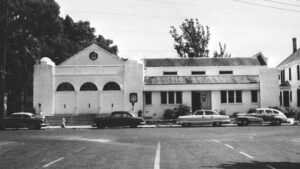
The Science Center’s first central location, the former B’nai Israel synagogue at 1039 Arlington Avenue. The City leased the property to the newly-formed nonprofit for $1 per year. Photo: Florida Archives.
Guild’s pleas for a larger, centralized space were answered by the City, which offered the Science Center use of the former B’Nai Israel synagogue at 1039 Arlington Avenue, for $1 per year. The synagogue had relocated after the congregation outgrew the building.
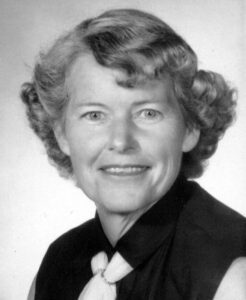
Nell Croley
“Our hope is to attract not only the all around gifted child, but also perhaps to uncover the unsuspected gift, which so many children have but which never comes to light,” director Nell Croley told the St. Petersburg Times in 1959, after the Science Center had settled into the Arlington location.
A longtime science teacher at Pinellas Park Elementary School, Croley had a Masters in Science Education.
A board of directors and governor’s council were created to oversee the new nonprofit organization. Instructors were hired, mostly retired public school teachers. The Science Center could take as many as 300 students.
In May, 1960, Guild was given an award by the Community Welfare Council. It was reported that he did not attend the banquet “because he was at a meeting trying to raise money for the Science Center.”
Two months later, he was out, with no public explanation offered:
The St. Petersburg Science Center has been closed until Oct. 1 for a reorganization.
William Guild, founder of the Center, was given until Aug. 1 to remove articles belonging to him from the Center building at 1039 Arlington Avenue N.
Dr. Leonard Freed, chairman of the center’s board of directors, said a program committee will work out projects during the reorganizational period.
St. Petersburg Times/July 12, 1960
The city’s evening paper reported that all the center’s locks had been changed, and that “Uncle Bill” was furious.
Although Guild remained in St. Petersburg, the Science Center went on without him.
Guild died of cancer on Nov. 20, 1962 in New York, at age 70. He had been staying with his daughter while receiving treatment.
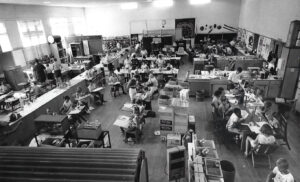
1964: Main lab room at the Arlington Avenue location. Photo provided.
Under the direction of Nell Croley, with funding from grants and private donations, the Science Center continued to prosper.
St. Petersburg has received national recognition because of its Science Center.
Marsflight II, simulated flight launched by the center in 1961, was exhibited at the Air Force convention in Philadelphia in September of that year.
Feature stories about the Center have appeared in The National Observer, American Youth, Life and Teen Age.
St. Petersburg Times/July 21, 1963
The Science Center Guild was established in 1963 to fundraise. The goal was to escape the antiquated Arlington facility. Classes were at capacity, and space was tight. The three laboratories in the non-air conditioned building often reached 100 degrees.
The City wanted the property back, to demolish it and then expand 11th Street.
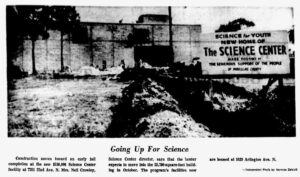
In September, the Science Center paid the city $15,000 for five acres of pine trees and palmetto scrub on 22nd Avenue N. Ground was broken a year later. The Guild was dispatched to raise $150,000 for the new two-story, 73,000-square-foot building, which could handle twice as many students as its predecessor.
Croley and her team were thrilled that the new location was on the west side of town, making it much more likely that students from Largo, Clearwater and even further could make the pilgrimage and learn about science.
In the final tally, the cost was $166,000. But the improvements were significant. The (fully air-conditioned) facility included six labs, a library, a theater, workrooms, offices and (separately, out in back) a telescope in a small observatory. There was a garden, which in time would include a mosaic walkway depicting all 50 states.
After several construction delays, the St. Petersburg Science Center was dedicated on March 5, 1966. Representatives from every St. Pete club, organization and business that had contributed, through money, labor, or both, were there to hear a speech from G.A. Van Staden, assistant administrative director for the John F. Kennedy Space Center.
Jack King, the voice of NASA’s Mission Control Gemini missions, performed the countdown to the ceremonial ribbon-cutting.
“We’ve come a long way from Uncle Bill Guild’s garage,” center director Croley said from the podium. “I think we’ve made it.”
COMING MONDAY: Part Two (The Glory Years)



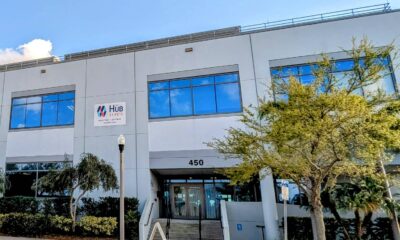

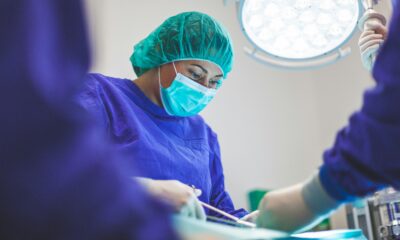

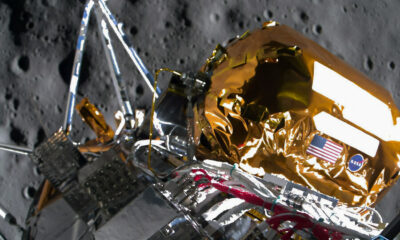

Scott Simmons
May 11, 2024at11:11 pm
Another great story Bill. I remember the 22nd Avenue North Building well. Thanks!
Kathleen McDole
May 11, 2024at5:16 pm
Wonderful history Bill! The woman who ran it in the 80’s previously had a toy shop on Corey Ave on St Pete Beach. She ended up a Queen of Hearts recipient and her husband was the Mayor of one of the Beach Islands!